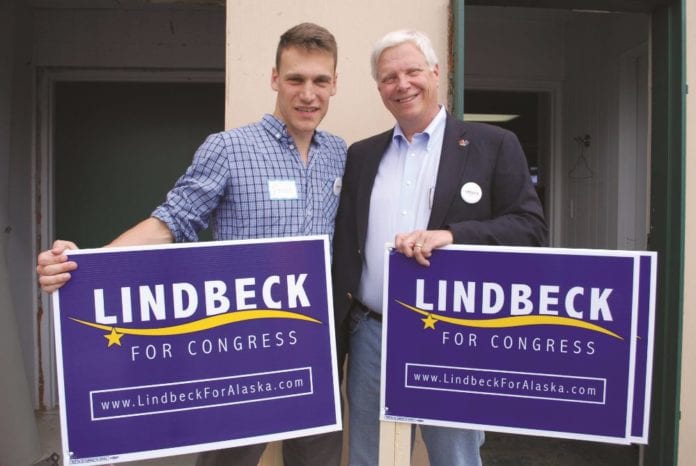
Nine candidates in all are lined up to compete in the Aug. 16 primary election campaign for Alaska’s lone seat in the U.S. House, which has been held by Rep. Don Young, R-Alaska, since a special election on March 6, 1973.
Challenging Young on the Republican primary ballot will be Gerald Heikes, who sought the GOP nomination for governor in the 2014 primary; Jessie Tingley and Stephen Wright.
On the Democratic ballot, the contenders include former public radio executive Steve Lindbeck, William Hibler, and Lynette Hinz, who was a 2012 Democratic candidate for District 25 in the Alaska House.
On the Libertarian primary ballot the candidates include Jim McDermott, a business instructor at the University of Alaska and Air Force veteran who ran unsuccessfully for the same seat in 2012 and 2014, and Jon Briggs Watts.
Winners in each primary election will face each other in the Nov. 8 general election.
Alaska utilizes a hybrid primary system, also known as a semi-closed primary, in which political parties may decide for themselves whether to permit voters who are unaffiliated or are members of another party to participate in their primary.
Thus, in Alaska, the Democratic, Libertarian and Alaska Independence parties will allow any registered voters to choose to vote in their primaries, while the Alaska Republican Party allows only registered Republicans, nonpartisan and undeclared voters to vote in the Republican primary.
Young, a native of California, came to Alaska in 1959, and ran successfully for mayor of Fort Yukon in 1964, then served in the Alaska House of Representatives from 1967 to 1971, and in the Alaska Senate from 1971 to 1973, before running for Congress in 1972, losing to incumbent Rep. Nick Begich, D-Alaska who disappeared in a plane crash before the election.
The plane was never found and Young went on to win a special election in March 1973.
Young is the third most senior U.S. Representative and most senior Republic Representative in the U.S. House.
Of the nine candidates, Young and Lindbeck are considered the frontrunners.
Young’s campaign website, www.alaskansfordonyoung.com, lists more than a dozen issues of concern to the incumbent, ranging from education, energy and health care to immigration, military defense and natural resources.
Lindbeck’s website, www.lindeckforalaska.com, also lists more than a dozen issues of concern, ranging from education, federal fiscal responsibility and Wall Street reform to energy, climate change and renewable energy, and keeping Alaska’s fishing industry healthy.
Both have plenty to say about Alaska Native, education, and energy issues, among other matters.
Young, who calls Fort Yukon home, chairs the House Natural Resources Subcommittee on American Indian and Alaska Native Affairs, which oversees matters regarding Native Americans, including the 566 federally recognized tribes, Alaska Native corporations and nearly 1.9 million American Indians. As chairman of the subcommittee, Young states on his campaign website that he is working to protect and promote economic development opportunities for Indian tribes across the country.
Native communities are also of concern to Lindbeck, whose campaign statements include a strong commitment to protecting subsistence rights, honoring tribal self-determination and supporting rural economic opportunities. Lindbeck said he would fight for increased and meaningful tribal involvement in natural resource management and push for more scientific research and resources to monitor and maintain Alaska’s world-class salmon fisheries that are vital to subsistence users.
On the issue of energy, Young notes on his campaign website that he has passed legislation to open the Arctic National Wildlife Refuge to oil and gas development through the House 12 times, passed legislation through the House to open up more offshore areas to oil and gas development while ensuring Alaska gets its fair share of the revenues, and reduced the Environmental Protection Agency’s funding by $2.1 billion, or 20.4 percent since Republicans gained control of the House in 2010.
Lindbeck’s statement on energy says that Alaska must diversify its economy and that he will work with the energy industry to invest in both environmentally responsible natural resource development and renewable energy. While oil and gas development continue to dominate Alaska’s economy and will do so for he foreseeable future, despite low prices and declining production, he will have the backs of thousands of Alaska oil workers and prioritize local knowledge and safety, Lindbeck said.
The Democratic contender also said he would work to reauthorize the Magnuson-Stevens Fishery Conservation and Management Act, help young fishermen enter the fleet, oppose the introduction of genetically modified salmon and push for increased scientific efforts in monitoring Alaska’s oceans and coastal habitats. Lindbeck said he opposes development of the Pebble copper, gold and molybdenum mine adjacent to the Bristol Bay watershed.
Young has been critical of the EPA’s role is evaluating the potential for development of such a massive mine to adversely affect salmon habitat in the Bristol Bay watershed, and has in the past filed legislation seeking to strip the EPA of its authority to do so.
With re-election in November, Young said in his statement on natural resources, he can continue to work on reauthorization of the Magnuson Stevens legislation, streamline environmental regulations and increase access to federal lands for fishing, hunting and mineral development.
Read Young’s and Lindbeck’s complete issues statements online at the above websites.














